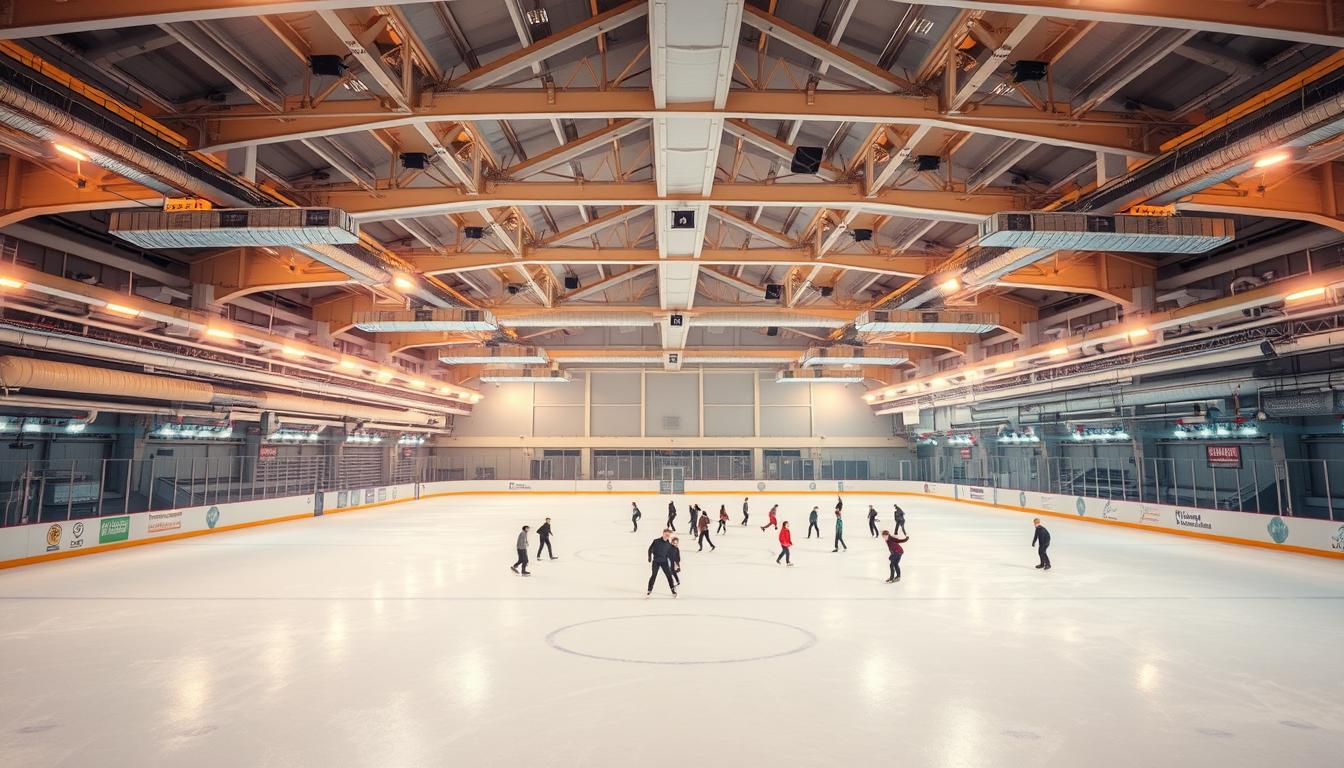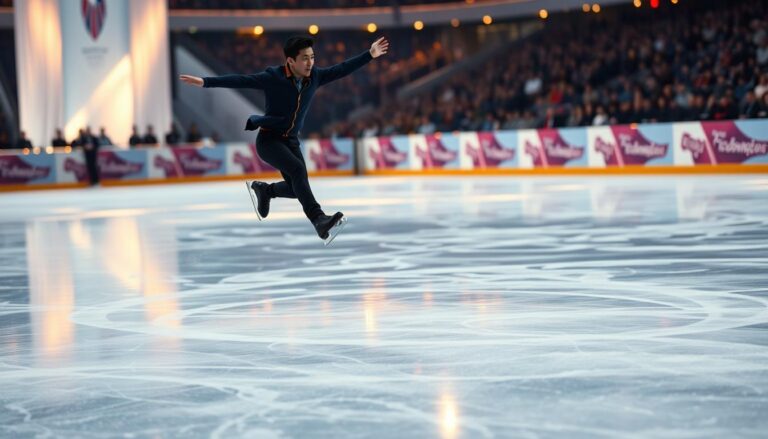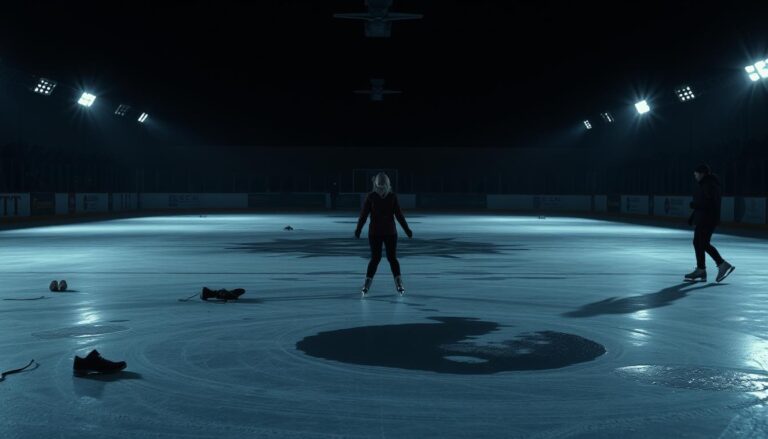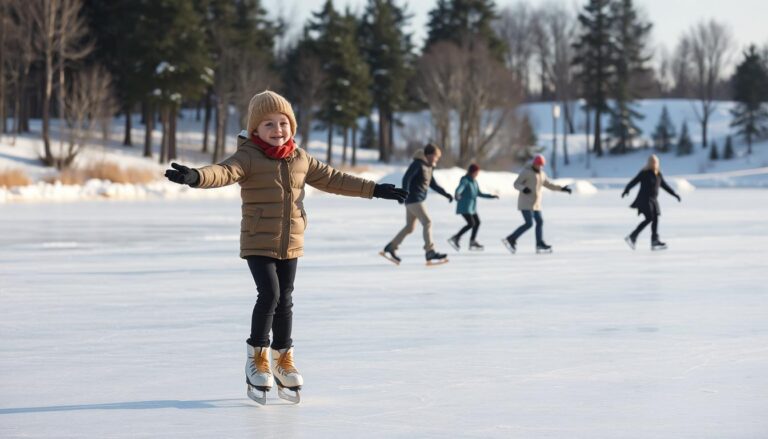The Minimum Temperature Cold is an ICE Skating Rink
Imagine stepping onto a perfectly crafted ice surface. Every glide feels like a dance between precision and passion. Ice rink temperature is more than just a number—it’s the foundation that turns a simple frozen surface into a dynamic playground.
Professional ice rinks keep a delicate thermal balance. The ice temperature is usually between 24-26 degrees Fahrenheit. This creates a complex environment where physics, engineering, and athletic performance meet. Understanding how cold an ice skating rink is reveals the science behind winter sports and recreational skating.
Professional facilities spend a lot on maintaining exact temperature zones. These controlled environments support casual skating and competitive events like figure skating and hockey. The temperature isn’t just for keeping water frozen—it’s for creating the best surface for athletic performance and safety.
Modern refrigeration technologies have changed how rinks manage their temperature. Advanced cooling systems keep the temperature consistent, ensuring good ice quality. Skaters enjoy smoother, more predictable surfaces thanks to these technologies.
Whether you’re a professional athlete or a weekend enthusiast, knowing about ice rink temperature is fascinating. From the moment you step onto the ice, you’re in a carefully engineered environment. It’s designed to support human movement in its most graceful and dynamic form.
Understanding Ice Rink Temperature Basics
Stepping onto an ice skating rink is like entering a carefully engineered environment. Temperature plays a key role here. It’s not just about keeping things cold – it’s a precise science that turns water into the perfect skating surface.
The Science Behind Ice Formation
Creating the perfect ice surface requires a delicate balance of physics and engineering. The ice skating rink climate must be meticulously controlled for optimal skating conditions. Water molecules undergo a fascinating transformation when cooled to their freezing point. This creates a smooth, solid surface for graceful glides and powerful hockey moves.
- Freezing point of water: 32°F (0°C)
- Ideal ice surface temperature: 24-26°F (-4 to -3°C)
- Ambient air temperature: 50-60°F (10-15°C)
Temperature Zones in an Ice Rink
Ice rinks are complex environments with multiple temperature zones. Each area requires specific climate control for the perfect skating conditions:
- Ice Surface Layer: The most critical zone
- Immediate Air Above Ice
- Rink Perimeter
- Upper Ventilation Areas
Critical Temperature Thresholds
Skaters and rink managers know that even slight temperature variations can dramatically impact ice quality. Too warm, and the surface becomes soft and sluggish. Too cold, and the ice becomes brittle and prone to cracking.
| Temperature Range | Ice Condition | Skating Impact |
|---|---|---|
| 24-26°F | Optimal Ice Condition | Smooth, Fast Skating |
| 27-30°F | Soft Surface | Slower, Sticky Skating |
| Below 23°F | Brittle Ice | Rough, Uneven Surface |
How Cold is an Ice Skating Rink
Many people wonder about the temperature of an ice skating rink. The ideal temperature is between 24°F and 28°F (-4°C to -2°C). This ensures the ice is perfect for all skaters.
Knowing the exact temperature of an ice rink is more than just a number. Professional rinks balance air and surface temperatures for the best skating experience.
- Surface temperature is usually 24-25°F
- Air temperature stays between 50-60°F
- Humidity is controlled to keep the ice from melting
Different skating activities need slightly different temperatures. Figure skating needs harder ice, while hockey prefers softer ice. The right temperature is key for performance and safety.
Refrigeration systems keep the temperature just right. They cool the ice from below, making sure the skating surface is always perfect.
The coldness of an ice rink can feel different to everyone. It depends on humidity, how hard you skate, and your body heat. Once you start moving, the rink feels cozy.
| Skating Type | Ideal Surface Temperature | Air Temperature Range |
|---|---|---|
| Figure Skating | 24-25°F | 50-55°F |
| Hockey | 25-26°F | 55-60°F |
| Recreational Skating | 24-26°F | 50-60°F |
Rink managers always check the temperature to make sure it’s perfect. Keeping the ice at the right temperature is both an art and a science.
Ideal Temperature Range for Professional Ice Rinks
Professional ice rinks are precise environments. Keeping the ice at the right temperature is key. Athletes need the perfect surface to perform at their best.
The ideal ice temperature varies by sport. This creates challenges for rink managers. Each sport needs a specific surface for performance and safety.
Competition Standards for Ice Surface
International skating groups set strict ice standards. These rules ensure fair play and top performance in winter sports.
- Figure skating needs softer ice surfaces
- Hockey requires harder, faster ice
- Temperatures usually range from 22°F to 26°F (-5.5°C to -3°C)
Figure Skating Requirements
Figure skaters need ice that’s just right. The optimal ice rink temperature for figure skating is around 24°F (-4.4°C). This temperature helps with precise edge work and smooth jumps.
Hockey Rink Specifications
Hockey requires a harder ice surface. Players need a surface that supports fast skating and less friction. Hockey rinks usually keep temperatures at 22°F (-5.5°C) for a quicker, more responsive game.
| Sport | Optimal Temperature | Ice Characteristics |
|---|---|---|
| Figure Skating | 24°F (-4.4°C) | Softer, more flexible surface |
| Hockey | 22°F (-5.5°C) | Harder, faster playing surface |
Knowing these temperature needs helps athletes and rink managers create the best conditions for top performances.
Factors Affecting Ice Rink Temperature Maintenance

Keeping the ice rink at the right temperature is a complex task. It involves many environmental factors. Rink managers must balance these factors to create the perfect ice surface. This balance is key for athletes and fun skaters.
Several key factors impact maintaining ice rink temperature:
- Occupancy levels and skater density
- Ambient humidity and air circulation
- Lighting systems and heat generation
- Ventilation and air exchange rates
- External temperature and weather conditions
The number of skaters on the ice affects temperature control. Each skater generates heat through movement. This heat changes the ice temperature, making it hard for rink operators. They use advanced systems to keep up with these changes.
Factors like humidity also play a big role in ice quality. Too much moisture makes the ice soft and slow. Too little makes it brittle and uneven. Climate control systems work hard to find the perfect balance.
Special events like hockey games and figure skating competitions bring their own challenges. Rink managers must adjust cooling systems to keep the ice quality high. This ensures everyone has a great time on the ice.
- Cooling system precision
- Regular surface maintenance
- Advanced temperature monitoring
- Strategic insulation techniques
Modern ice rinks use the latest technology to manage temperature. Sensors, automated controls, and algorithms help create the perfect skating environment. This ensures safety, performance, and fun for all.
The Role of Refrigeration Systems in Ice Rinks
Every smooth ice skating surface has a complex refrigeration system behind it. These systems keep the ice at the perfect temperature. They are the hidden heroes of ice skating, working hard to create the perfect climate.
Advanced Cooling System Technologies
Modern ice rinks use advanced refrigeration technologies. These ensure the ice is at its best. The main systems include:
- Direct Refrigeration Systems: Pipes circulate coolant directly beneath the ice surface
- Glycol Cooling Networks: Uses antifreeze solution for more consistent temperature control
- Brine Circulation Methods: Saltwater solutions help maintain precise ice temperatures
Energy Efficiency Innovations
Rink operators are now focusing on green refrigeration solutions. They use:
- Heat recovery systems that capture and repurpose thermal energy
- Smart temperature monitoring technologies
- High-efficiency compressor designs
Modern Refrigeration Technologies
New technologies are changing how ice rinks manage temperature. Advanced sensors and AI-driven systems can now adjust temperatures with great precision. This ensures the ice is perfect for skating.
These advanced systems are a mix of science and sports. They create the perfect environment for both fans and athletes.
Seasonal Challenges in Temperature Control
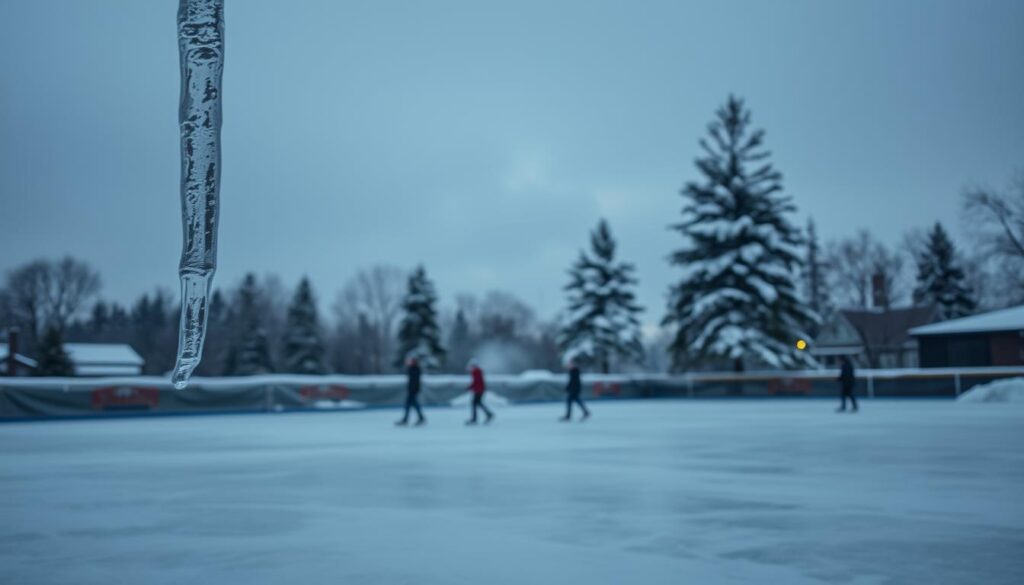
Managing an ice rink is like a dance with temperature all year. Outdoor rinks face special challenges that test managers’ skills. Summer heat makes the ice surface weak, needing constant watch and cool solutions.
But it’s not just about the temperature. Environmental factors like sunlight, humidity, and sudden temperature changes affect the ice. These factors make keeping the ice perfect a big task.
- Direct sunlight can quickly ruin the ice.
- Humidity levels greatly impact how well the ice performs.
- Unexpected temperature changes can make the ice unstable.
- Seasonal changes require quick adjustments.
Skilled rink managers use advanced tech to fight these challenges. Precision refrigeration systems come with smart sensors. These sensors track small temperature changes, letting managers make quick fixes to keep the ice good.
Climate change adds more trouble for outdoor rinks. Warmer winters and unpredictable weather make cooling harder. Managers must find new ways to keep the ice cool.
- They use reflective coatings on the ice.
- They add insulated layers under the ice.
- They create flexible cooling plans.
To handle these challenges, rinks need to keep learning and using new tech. The best rinks are adaptable, turning problems into chances to improve.
Indoor vs Outdoor Ice Rink Temperature Management
Skating fans know the perfect ice is a mix of science and skill. Whether you skate indoors or outdoors, keeping the right temperature is key. It makes the ice surface perfect for skating.
Indoor and outdoor rinks face different challenges. They need special ways to control temperature. This ensures a great skating experience for everyone.
Environmental Impact Factors
Outdoor rinks deal with nature’s wild side. Important factors include:
- Direct sunlight exposure
- Wind speed and direction
- Ambient temperature changes
- Precipitation and humidity levels
These factors can change the ice quality. This makes outdoor rinks harder to keep in top shape than indoor ones.
Climate Control Solutions
Rink managers use smart ways to handle temperature issues:
- Indoor Rinks: Use advanced cooling systems for exact temperature control
- Outdoor Rinks: Use covers and pick the right location
- Apply special insulation
- Monitor temperature in real-time
Keeping the ice right is a big job, indoors or outdoors. Knowing how to manage temperature ensures a safe and fun skate for all.
Temperature Monitoring and Control Systems

Modern ice rinks use advanced tech to keep the ice at the right temperature. These systems are key to a smooth skating experience. They work quietly to make sure the ice is perfect.
To keep the ice right, rinks use many tools. They have sensors and special equipment. This helps them keep the ice surface top-notch:
- Digital temperature sensors embedded in ice surface
- Infrared thermal imaging cameras
- Computerized climate control systems
- Humidity tracking devices
Keeping the ice at the right temperature is a big job. Precise calibration is very important. Small changes in temperature can affect how well the ice is and how skaters do.
New control systems use artificial intelligence. They can predict and stop temperature changes. These smart systems look at data in real time. They make quick changes to keep the ice perfect for skating.
Important ways to monitor include:
- Continuous surface temperature scanning
- Multi-point temperature gradient analysis
- Automated cooling system responses
- Remote management interfaces
Managers at professional rinks know it’s both an art and science. They use the latest tech to make sure the ice is always perfect. This helps skaters perform at their best.
Impact of Temperature on Ice Quality
The art of ice skating is more than just gliding on ice. The temperature of the ice rink is key to a great skating experience. Skaters say the quality of the ice can greatly affect their performance. Temperature is the main factor in how smooth or rough the ice is.
To understand how ice rink temperature affects the ice, we must look at the molecular level. Different temperatures lead to different skating experiences. You might get a smooth surface or one that’s bumpy and hard to skate on.
Surface Texture Analysis
Ice managers watch several things to check the ice quality:
- Crystal formation patterns
- Surface smoothness
- Ice density
- Reflectivity characteristics
The ideal temperature for ice skating is between 24-26 degrees Fahrenheit. At this temperature, ice crystals form perfectly. This makes the ice smooth and perfect for gliding and precise movements.
Safety Considerations
Temperature changes can be a big safety issue for skaters. If the ice gets too warm, it becomes soft and sticky. On the other hand, very cold ice can be brittle and uneven. This increases the chance of falls and injuries.
Professional rinks use advanced cooling systems to keep the temperature steady. This ensures skaters stay safe and perform their best. Keeping the ice at the right temperature is not just about comfort. It’s about safety and top-notch performance.
Skaters and rink managers must work together to manage these temperature changes. They turn a simple sheet of ice into a dynamic, responsive surface for athletes to excel on.
Energy Conservation in Ice Rink Temperature Management
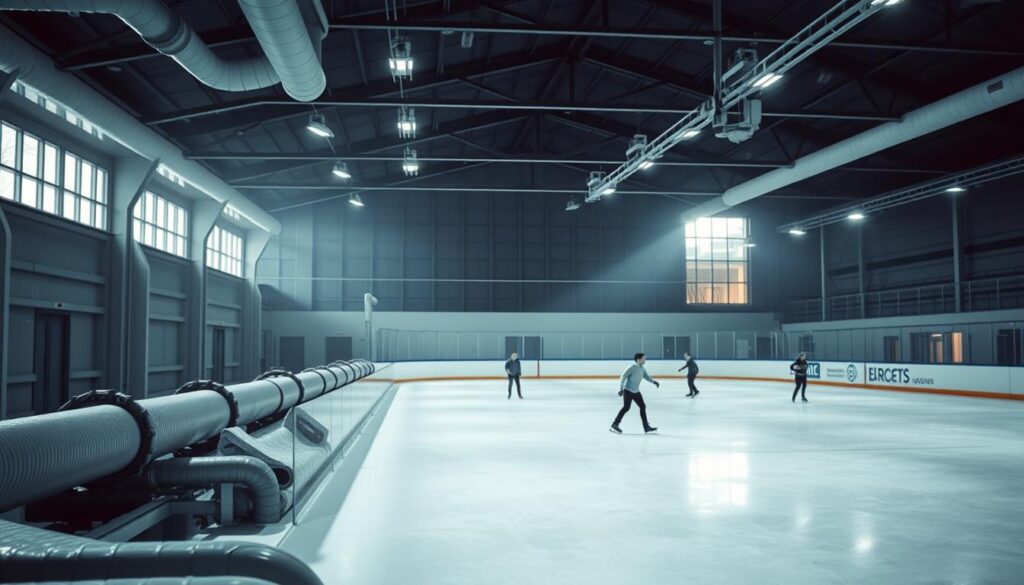
Keeping ice rinks cool needs smart energy plans. These plans aim to save energy without sacrificing skating quality. Modern ice facilities are leading the way in this effort.
New ways to keep ice rinks cool are key for managers. Saving energy is now a top goal for keeping things running smoothly.
- Implement advanced refrigeration technologies
- Utilize heat recovery systems
- Optimize building insulation
- Leverage renewable energy sources
New cooling systems cut down on energy use. Smart refrigeration technologies can save up to 40% of electricity compared to old methods.
| Energy Conservation Method | Potential Energy Savings | Implementation Difficulty |
|---|---|---|
| High-efficiency compressors | 25-35% | Moderate |
| Thermal energy storage | 20-30% | Complex |
| Waste heat recapture | 15-25% | Low |
Using renewable energy is a big step forward. Solar panels and geothermal systems are green options. They help lower carbon emissions and keep the ice cool.
Managers can cut costs by saving energy. The future of ice rinks is about being both top-notch and eco-friendly.
Common Temperature-Related Issues and Solutions
Keeping an ice skating rink at the right temperature is tough. Changes in temperature can cause big problems for those in charge. It’s key to keep the ice perfect for skating safely.
To keep the ice right, you need to be ready for any temperature issue. Skaters and rink owners face many challenges. These can hurt the quality and how well the ice works.
Troubleshooting Temperature-Related Ice Problems
Rink managers must watch for temperature problems closely. The main issues are:
- Soft ice patches from uneven cooling
- Frost near the rink edges
- Condensation and fog
- Uneven ice surface
Preventive Maintenance Strategies
To control the ice rink’s climate well, you need to take steps ahead:
- Keep an eye on the temperature
- Control humidity
- Keep refrigeration systems in good shape
- Train staff on managing temperature
| Issue | Root Cause | Prevention Strategy |
|---|---|---|
| Soft Ice | Temperature Fluctuations | Precise Cooling Control |
| Frost Build-up | Humidity Imbalance | Dehumidification Systems |
| Surface Irregularities | Uneven Cooling | Regular Resurfacing |
Professional rinks use the latest tech to spot temperature changes fast. With these steps, they can keep the ice great for all skaters.
Best Practices for Temperature Maintenance
Keeping the ice rink at the right temperature is an art. It makes a big difference between a top-notch skating spot and just any place. The best rinks use exact temperature control to make the ice perfect for skating.
There are a few key steps to keep the ice rink temperature just right:
- Always check the surface and air temperatures
- Make sure the cooling systems are working well
- Know how the weather affects the ice
- Keep up with regular maintenance
Ice experts say it’s all about layers when it comes to temperature control. The best temperature for ice skating is between 24-26 degrees Fahrenheit. This keeps the ice just right, not too soft or too hard.
Here are some important steps for keeping the ice temperature perfect:
- Keep a daily log of temperatures
- Check the ice every hour
- Use the latest tech to monitor the temperature
- Train staff on how to control the temperature
Top rinks use advanced systems to track temperature in real-time. This lets them adjust quickly to keep the ice quality high all day.
Seasonal changes make temperature control harder. But, skilled managers adapt by considering humidity, outside temperature, and how many people are skating. The best places see temperature control as a constant effort, not just a one-time thing.
Future Trends in Ice Rink Temperature Control
The world of ice rink temperature management is on the verge of a big change. Climate challenges and saving energy are key, leading to new solutions. These innovations will change how we keep ice rinks at the perfect temperature.
Emerging Technologies Reshaping Ice Rink Climate Control
New technologies are changing how we manage ice rink temperatures. Artificial intelligence and machine learning are creating smart systems. These systems can:
- Predict temperature changes with great accuracy
- Adjust cooling systems on the fly
- Save energy while keeping ice conditions perfect
Sustainable Solutions for Ice Rink Temperature Management
People are now focusing on making ice rinks more eco-friendly. Scientists are working on new ways to use less energy while keeping the ice perfect.
- Solar-powered refrigeration systems
- Energy-capturing ice surfaces
- Advanced thermal insulation technologies
The future of ice rink temperature control is exciting. New cooling technologies are more efficient and better for the environment. They ensure the ice is perfect for athletes and fun skaters.
Advanced Monitoring and Control Systems
Smart sensors and real-time data are changing ice rink temperature management. These systems can spot tiny temperature changes. This means we can control the climate more precisely than ever before.
With smart cooling algorithms and green refrigeration, the future of ice rink temperature control is bright. It’s sustainable and full of new technology.
Conclusion
Exploring how cold an ice skating rink is shows us a world of precision and skill. Ice rinks, from Olympic training to local centers, need careful temperature control. This ensures a safe and great skating experience for everyone.
Ice rink temperature is more than just a number. It’s about making a consistent, top-notch surface for all skating. Professional places use advanced cooling and monitoring to keep the ice just right. This helps both new and experienced skaters perform their best.
The future of ice rink temperature looks bright, with new, green technologies on the horizon. These include better cooling methods and smart systems to keep the ice perfect. The industry is working hard to make ice surfaces better for skating and the planet.
When you skate, you’re part of a world where science and tech come together. Skating seems simple, but it’s backed by a complex system designed for the perfect ice. Whether you’re interested in the tech or just love skating, the world of ice rink temperatures is fascinating.
